John O’Keefe, May-Britt Moser and Edvard Ingjald Moser win The Nobel Prize in Physiology or Medicine 2014. The prize was given “for their discoveries of cells that constitute a positioning system in the brain”. 50% of the prize money will be awarded to John O’Keefe and the remaining 50% will be jointly awarded to May-Britt Moser and Edvard Moser.
The three Nobel Laureates discovered key aspects of the advanced positioning system in the brain. It is through their discoveries that we understand the fundamentals of where we are at a given location and how to find our way to another. Brain activity governs these abilities, and these scientists identified cells and locations in the brain that perform these functions
John O’Keefe (b1939)
John is a Professor and neuroscientist from University College London, UK. He addressed this problem recording nerve activity in hippocampus of freely moving rats. He found that certain cells were only active when the rat was moving/in a particular position. He called these cells ‘place cells’, since these were only active at specific places in the environment. O’Keefe postulated that activity of these cells create an inner map of the surrounding environment. He found that the same set of place cells were active if the rat visited the same environment, while a different combination of cells were active when it visited another environment.
[hr style=none margin_top= margin_bottom=]
May-Britt Moser (b1963) and Edvard Moser (1962)
The Mosers are Professors at the Kavli Institute for Systems Neuroscience, Norwegian University of Science and Technology, Norway. More than 30 years after John O’Keefe’s discovery, May-Britt and Edvard Moser found another component in the system. They were recording cells in the entorhinal cortex of rats, and identified the ‘Entorhinal Grid Cells’. They found that different combinations of these cells were active in different locations. These cells provided rats with a coordinate system that it used for navigation in the external world.
[hr style=none margin_top= margin_bottom=]
Impact
The Grid Cells and Place Cells form and ‘inner GPS’ in the brain. Recent work in humans identified similar cells within similar locations of the brain. These discoveries provided a paradigm shift and opened a new avenue of how cognitive processes are integrated.






